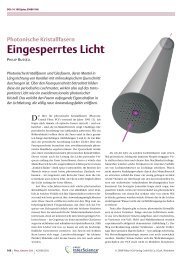Diploma thesis
Diploma thesis
Diploma thesis
You also want an ePaper? Increase the reach of your titles
YUMPU automatically turns print PDFs into web optimized ePapers that Google loves.
By inserting the corresponding terms into the two-photon-state we obtain:<br />
� ∞ � ∞ � b � b<br />
|Ψs,i〉 = A dωs dωi dx dyEp(x, y)Es(x, y)Ei(x, y)<br />
0<br />
0<br />
0<br />
0<br />
e − (ωs+ωi−ωp)2 2σ2 ∆kL<br />
−γ(<br />
e 2 )2<br />
â † s (ωs) â †<br />
i (ωi) |0〉 . (3.33)<br />
The waveguiding structures in our laboratory are tooth shaped as shown in Fig.<br />
3.16. To calculate the modal overlap we approximate this waveguide as a twodimensional<br />
rectangular structure of width and height b, with perfect conducting<br />
edges, as depicted in Fig. 3.17.<br />
Figure 3.16: Real waveguide (50x) Figure 3.17: Assumed 2D waveguide<br />
The transversal modes for this scenario are:<br />
�<br />
nπ<br />
Eµ(x, y) = Aµsin<br />
b x<br />
� �<br />
mπ<br />
sin<br />
b y<br />
�<br />
n, m ∈ N\{0}. (3.34)<br />
Equation 3.33 is separable, i.e. E(x, y) = E(x)E(y), and leads to two independent<br />
integrals.<br />
� b � b<br />
dx dyEp(x, y)Es(x, y)Ei(x, y)<br />
0<br />
0<br />
� L<br />
� L<br />
= dxEp(x)Es(x)Ei(x) dyEp(y)Es(y)Ei(y) (3.35)<br />
0<br />
We solve this one dimensional integration as follows:<br />
� b �<br />
nπ<br />
dx sin<br />
0 b x<br />
� �<br />
mπ<br />
sin<br />
b x<br />
� �<br />
oπ<br />
sin<br />
b x<br />
�<br />
= b<br />
4π (<br />
1<br />
1<br />
cos(π(n + m + o)) +<br />
cos(π(−n + m − o))<br />
n + m + o −n + m − o<br />
1<br />
1<br />
+ cos(π(n − m − o)) +<br />
cos(π(−n − m + o))) (3.36)<br />
n − m − o −n − m + o<br />
16<br />
0



